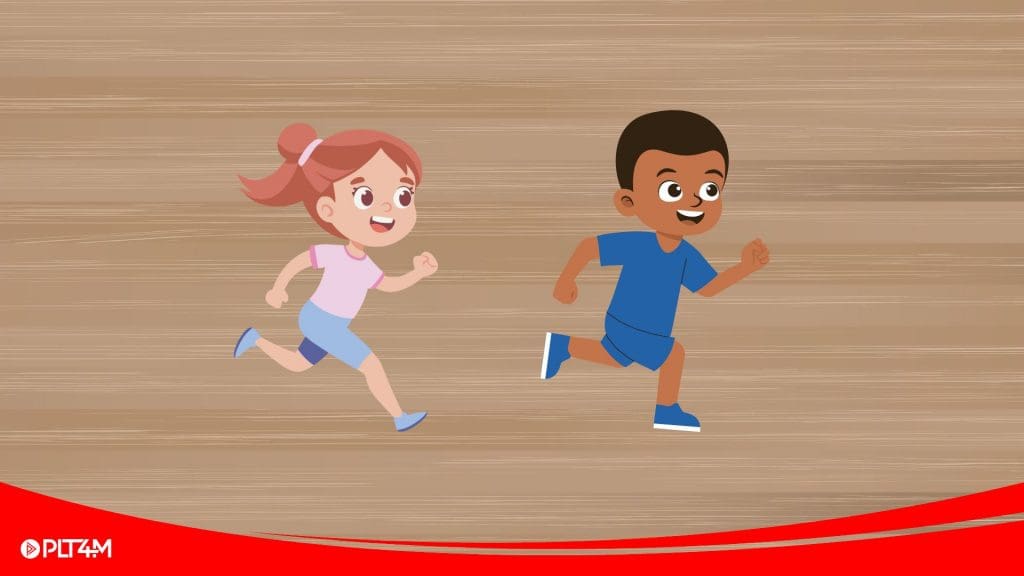Invasion games for elementary PE offer more than just excitement and energy—they’re a powerful tool for teaching key movement concepts like offensive and defensive positioning, teamwork, spatial awareness, and agility. These dynamic games challenge students to think strategically while staying active, helping them develop both physical and cognitive skills.
In this article, we’ll break down how invasion games connect to SHAPE standards, provide a range of fun and adaptable game ideas with clear instructions, and share a full sample lesson from PLT4M’s K-5 physical education curriculum to help you confidently implement these activities in your classroom.
What Are Invasion Games?
Invasion games are typically team-based games where players aim to score by entering the opponent’s territory while also defending their own playing area and preventing the other team from scoring.
While invasion games are often associated with traditional team sports like soccer, basketball, football, ultimate frisbee, and hockey, they can also be adapted in creative and age-appropriate ways for students at all grade levels.
In elementary physical education, there are countless invasion games that help students develop physical skills, social skills, teamwork skills, and more. In fact, even many classic tag games are considered excellent lead-up activities, introducing the basic concepts of invasion games to young learners.
From there, as students’ skill levels progress, PE teachers can introduce a wide variety of invasion-style games that build on these foundational skills in fun and engaging ways.
Get Free Sample Lessons!
Explore our K-5 Curriculum with these select Lesson Plans from some of our most popular Units. Each lesson includes a one page lesson overview, equipment checklist, game setup, teaching cues, standard alignment and more!
Standard-Aligned Invasion Games for Elementary PE
Invasion games for elementary PE go beyond just play—they offer a purposeful and engaging way for students to explore key movement and fitness concepts outlined in SHAPE America Standard 2: Applies knowledge of concepts, principles, strategies and tactics related to movement and performance.
These games challenge students to work together as teams, make quick decisions, and develop spatial awareness, all while learning the basics of offense, defense, and territory control in an age-appropriate way.
Depending on the grade level, invasion games can support the following SHAPE sub-standards related to strategy and tactics:
PreK–2: 2.2.2 – Identifies simple strategies in chasing and fleeing activities.
Grades 3–5: 2.5.2 – Demonstrates knowledge of offensive strategies in small-sided invasion practice tasks.
Grades 3–5: 2.5.3 – Demonstrates knowledge of defensive strategies in small-sided invasion practice tasks.
In addition to strategy and movement concepts, many invasion games naturally include opportunities to practice fundamental manipulative skills like throwing and catching, which are also part of SHAPE America Standard 1: Demonstrates competency in a variety of motor skills and movement patterns. These include:
PreK–2:
1.2.8 – Demonstrates catching in a variety of non-dynamic practice tasks.
1.2.9 – Demonstrates throwing in a variety of non-dynamic practice tasks.
Grades 3–5:
1.5.10 – Demonstrates throwing in a variety of practice tasks.
1.5.12 – Demonstrates catching in a variety of practice tasks.
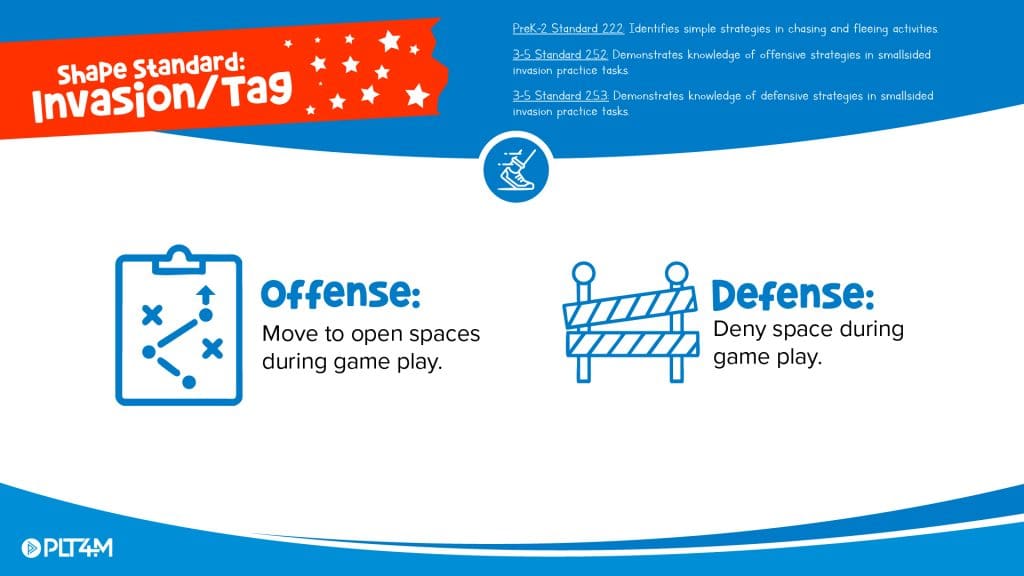
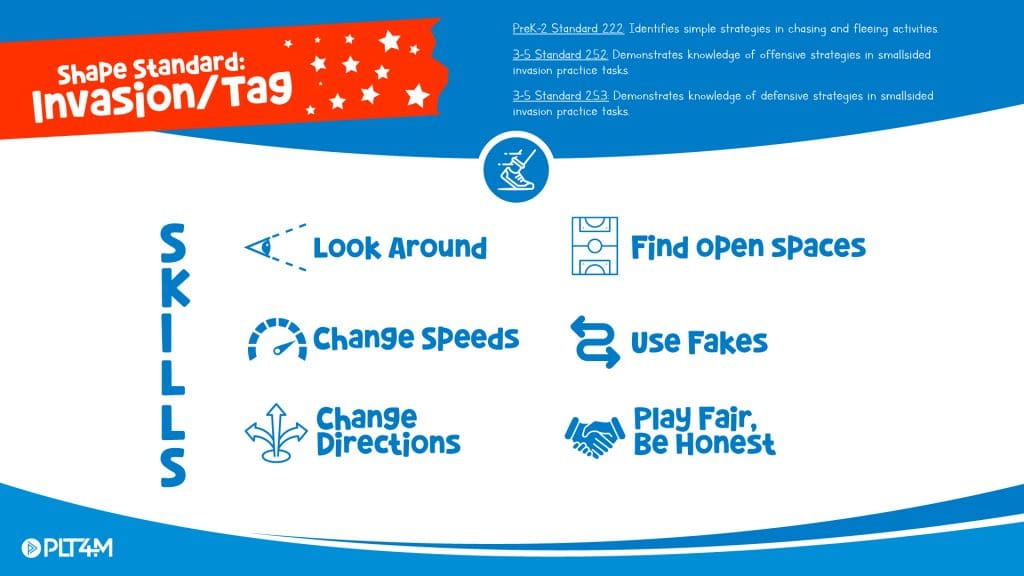
Teaching Specific Skills For Invasion Games For PE
Invasion games for elementary PE may seem simple on the surface, but they introduce students to foundational movement and gameplay concepts that serve as the building blocks for more complex physical activities. These team games naturally teach students different skills on how to move with purpose, make quick individual and team strategy decisions, and engage with others in both cooperative and competitive ways.
Specific Skills include:
Look Around – Always stay aware of your surroundings, including teammates, opponents, and the ball (if applicable), so you can make smart decisions during gameplay.
Change Speeds – Use bursts of speed or slow down strategically to get open, beat defenders, or recover on defense.
Change Directions – Sharp cuts and quick turns help you lose defensive players on offense or stay with your mark on defense.
Find Open Spaces – Position yourself in areas where defensive players are not, so you’re available for a pass or can help create space for others.
Use Fakes – Use body movements, eye direction, or footwork to trick defenders and gain an advantage.
Play Fair – Compete with respect by following the rules, accepting referee decisions, and showing good sportsmanship.
Be Honest – Own up to fouls or out-of-bounds plays to keep the game respectful and fun for everyone.
In invasion games, students experience both offensive and defensive roles:
Offense: Move to open spaces during gameplay.
Defense: Deny space during gameplay.
Overtime, players will develop more strategic knowledge on invasion games and find unique ways to succeed depending on the game situation.
Get Free Sample Lessons!
Explore our K-5 Curriculum with these select Lesson Plans from some of our most popular Units. Each lesson includes a one page lesson overview, equipment checklist, game setup, teaching cues, standard alignment and more!
6 Invasion Games Examples For Elementary PE
In PLT4M’s library of over 150 elementary PE lesson plans, there are 6 engaging invasion games designed specifically for younger students. These games are perfect for introducing key movement concepts and strategies while keeping students active and engaged. Most of these invasion games can be used as warm-ups, instant activities, or full-lesson games that encourage teamwork, spatial awareness, and skill development.
Here’s a look at six invasion games from the PLT4M library:
Catch 5 – A fast-paced, small-sided game that gets students working together to move to open spaces, defend players, and make accurate throws and catches.
Hoop Ball – A dynamic, small-sided game where teams advance the ball down the court, find open space, defend their opponents, and work together to score.
King Pin – A large-group invasion game that combines elements of throwing, defending, tagging, and even shooting a basket for added challenge and fun.
Pin Ball – Another fast-paced, small-sided invasion game where teams try to score by moving the ball down the court while focusing on spacing, defense, and teamwork.
Ring Raiders – A large-group game focused on stealing and protecting rings, promoting both offensive and defensive strategies while emphasizing team coordination.
Steal the Treasure – A simple but exciting invasion activity where students compete in small-sided games to steal and protect “treasure,” building basic tactics and game sense.
And as mentioned, invasion games also consist of other games, activities, and traditional team sports like soccer, basketball, and more—offering a wide range of options for teaching strategy, movement, and teamwork at every grade level.
Example Invasion Game Lesson From PLT4M’s Tag Games For Elementary PE
Check out an example of invasion games from one of PLT4M’s lessons for elementary PE. Featured in this blog is Catch 5.
In each lesson, PLT4M provides the following materials and resources for successful implementation of fun and exciting PE games and activities:
Activity Sheet – Great For Lesson Prep or PE Sub Plans!
Cues & Skill Standards
Equipment Checklist
Game Set Up
Step by Step Directions
Best Practices
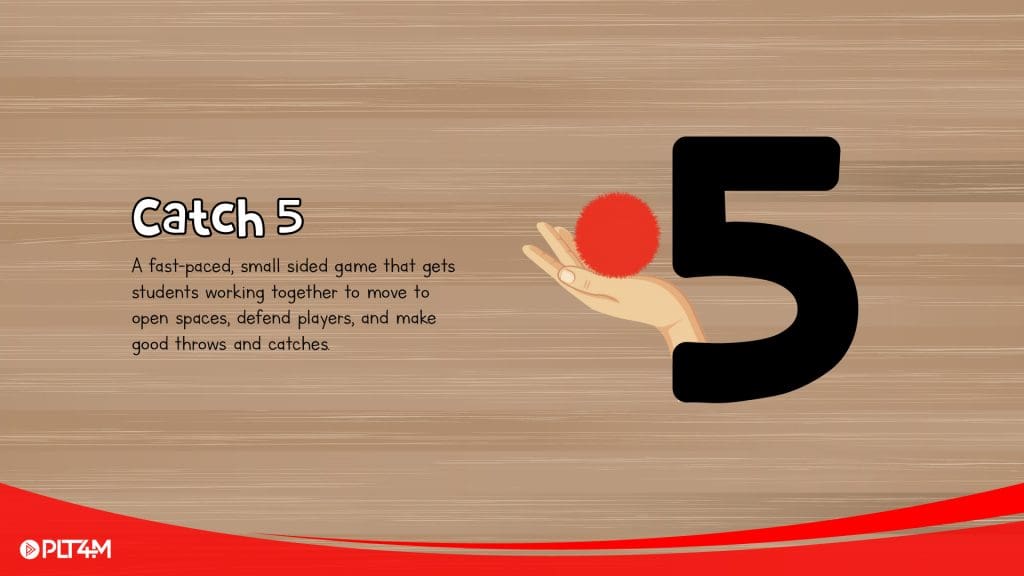



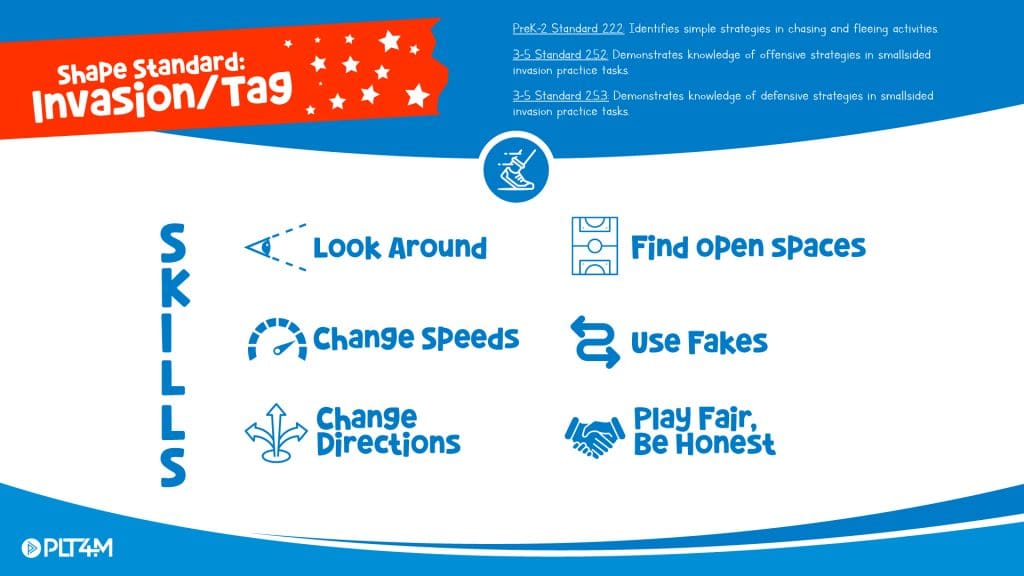
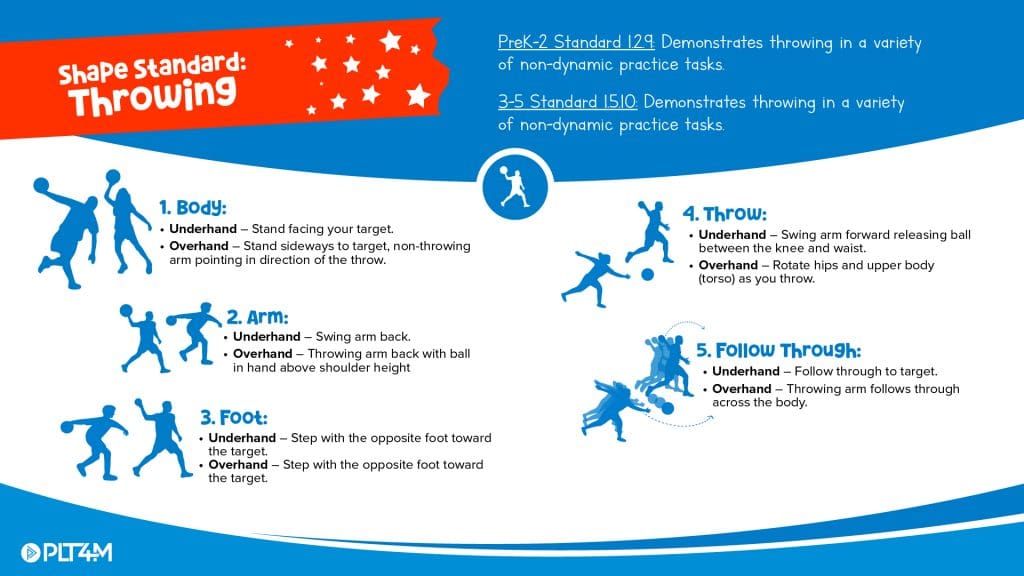
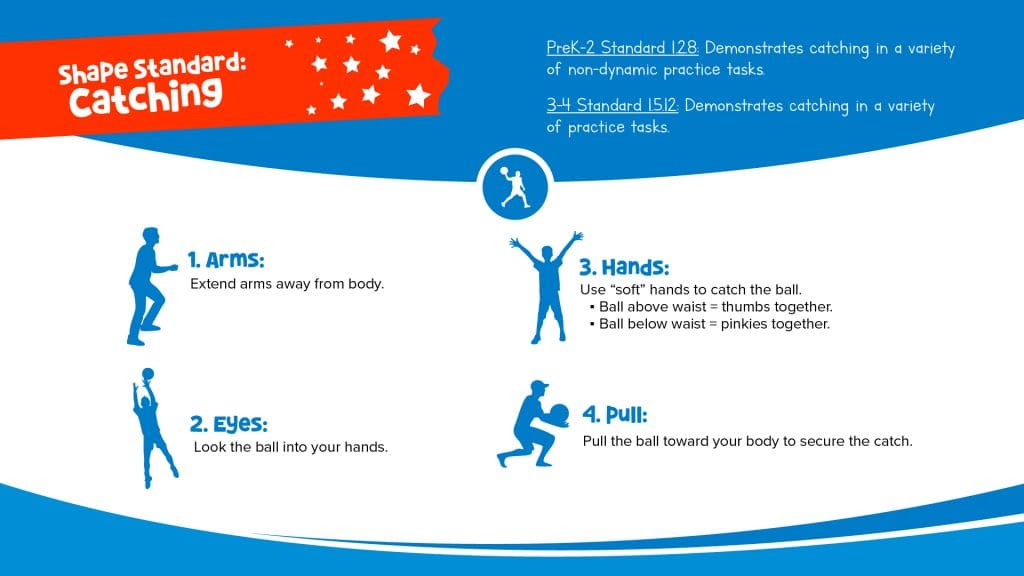





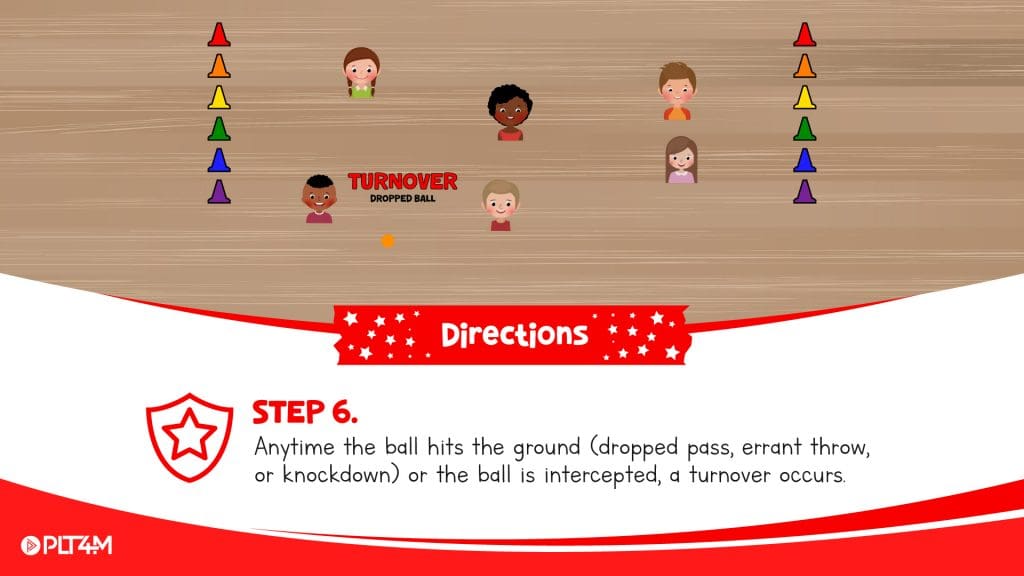

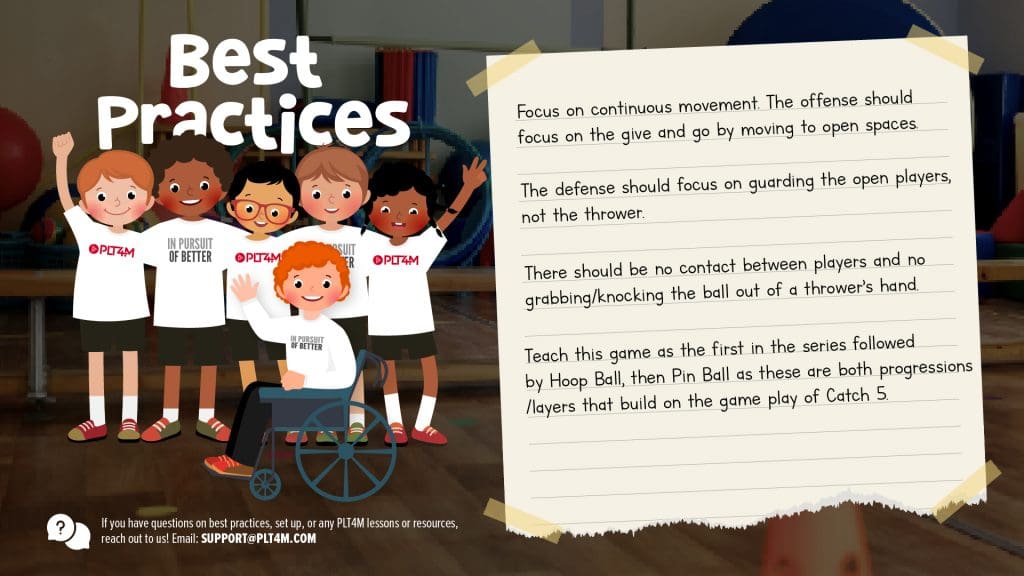
Key Takeaways on Invasion Games for PE
Invasion games come in countless forms and can be easily adapted for elementary students, offering a wide range of opportunities to build physical and tactical skills.
By incorporating a variety of invasion-style activities, you can create a fun and inclusive PE unit that helps students of all abilities improve in areas like spatial awareness, teamwork, strategy, and movement.
While this blog highlights just a handful of options, PLT4M provides full unit resource packs, lesson plans, and more. Reach out to learn how you can elevate your PE program with PLT4M’s engaging and effective resources!
Bonus – Check Out Other Elementary Physical Education Content
- PE Games For Elementary
- Elementary PE Lesson Plans
- Elementary Physical Education Curriculum
- Basketball Games For Elementary PE
- Jump Rope Activities For Elementary PE
- Tag Games For Elementary PE
- Soccer Games For Elementary PE
- Teaching Underhand Roll Via Bowling Lesson Plans
- Mike Graham, PE Teacher, Partners With PLT4M
